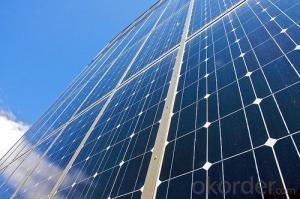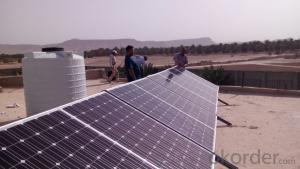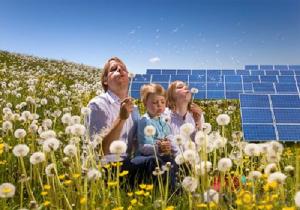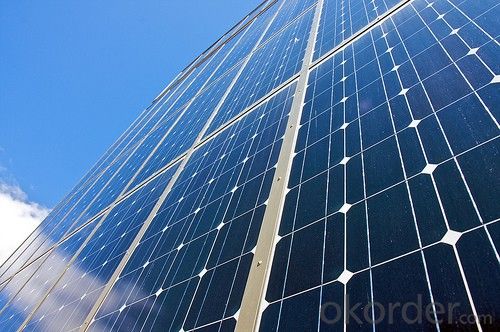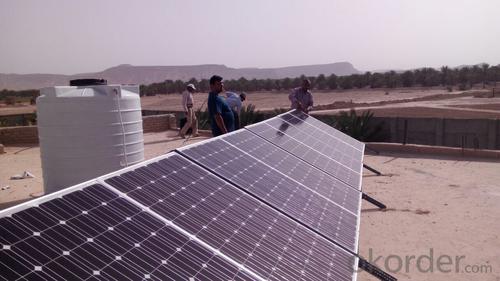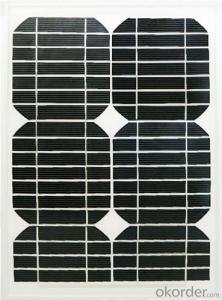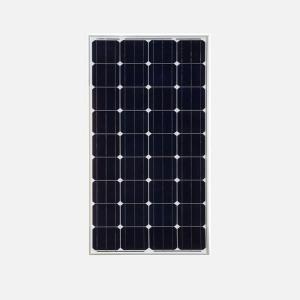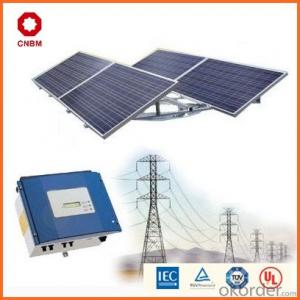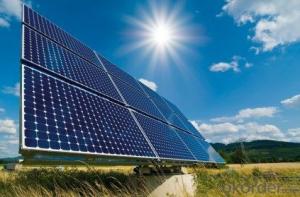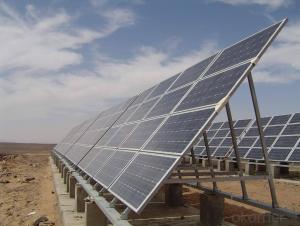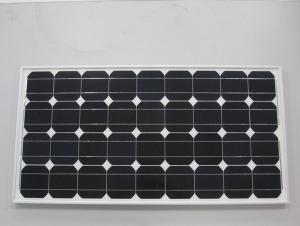Hurricane-Resistant Mono Solar Panels for Solar Energy Systems
- Loading Port:
- China main port
- Payment Terms:
- TT OR LC
- Min Order Qty:
- 10000 watt
- Supply Capability:
- 100000000 watt/month
OKorder Service Pledge
OKorder Financial Service
You Might Also Like
Specification
Production description
Type:Solar Monocrystalline 125mm Panel Series
Excellent features:
1.High efficiency crystalline silicon solar cell. Even if under the weak light, the solar module can produce maximum power output.
2.Tempered glass (toughened glass): Anti-reflecting coating and high transmission rate glass increase the power output and mechanical strength of solar module.
3. EVA and TPT: Using high quality EVA and TPT to prevent destroying and water.
4. AI frame: Without screw, rner connection. 6 holes on the frame can be installed easily.
5. Junction box: Multi function junction box with water proof.
6. Long lifetime: ≥25 years; Less power decrease.
7. Good performance of preventing from atrocious weather such as wind and hails.
8. Resisting moisture and etching effectively, not effected by geology.
Certificate:UL,TUV,IEC,CE
Details
Characteristics
Max Power Voltage Vmp (V) | 17.4A | 17.8A |
Max Power Current Imp (A) | 2.59A | 2.81A |
Open Circuit Voltage Voc (V) | 22.4V | 22.6A |
Short Circuit Current Isc (A) | 2.75A | 2.99A |
Max Power Pm (W) | 45W | 50W |
Temperature Coefficient of Cells
NOCT | 47℃±2℃ |
Temperature Coefficients of Isc (%/ ℃) | +0.06% |
Temperature Coefficients of Voc (%/ ℃) | -0.33% |
Temperature Coefficients of Pmp (%/ ℃) | -0.45% |
Mechanical Data
Typeof Cells(mm) | Mono125 x 62.5 |
Dimension | 630x550x30mm |
Weight | 4.5kg |
NO. of Cells and Connections | 4x9=36 |
Images
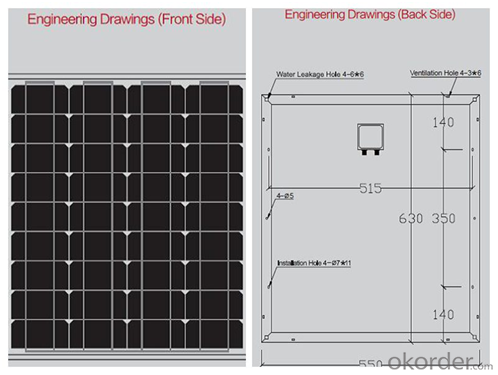
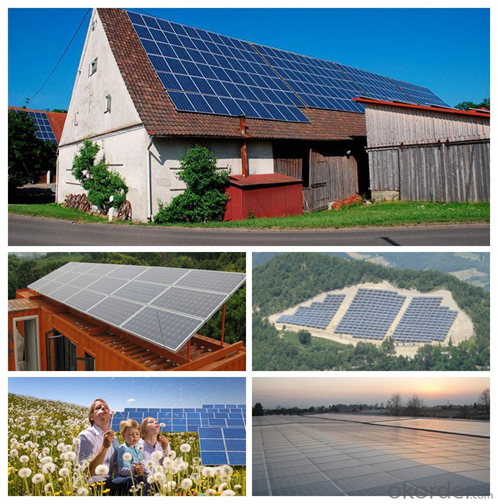
FAQ
We have organized several common questions for our clients,may help you sincerely:
1.What price for each watt?
It depends on the quantity, delivery date and payment terms,
2.Can you provide the peripheral products of the solar panels, such as the battery, controller, and inverter? If so, can you tell me how do they match each other?
Yes, we can, we have two companies for solar region, one is CNBM International, the other is CNBM engineering Co.
We can provide you not only the solar module but also the off grid solar system, we can also provide you service with on grid plant.
- Q: i need how a solar panel works, if possible make as easy to understand as possible like because of this , this happens and if you could please put a web source you got it from
- Sunlight (photons) hit a piece of silicon and knock electrons out of it. That causes a flow of electrons, which is electrical current. simple enough? a better explanation from wikipedia: A solar cell is a device that converts the energy of sunlight directly into electricity by the photovoltaic effect. Sometimes the term solar cell is reserved for devices intended specifically to capture energy from sunlight such as solar panels and solar cells, while the term photovoltaic cell is used when the light source is unspecified.
- Q: Single crystal solar panels and polycrystalline solar panels
- Monocrystalline silicon cells in the laboratory to achieve the conversion efficiency of 24.7%. Ordinary commercial conversion efficiency of 10% -18%. Monocrystalline silicon solar cells because of the production process problems, generally its semi-silicon ingots for the cylindrical into, and then through the slice -> cleaning -> diffusion knot -> remove the dice -> the production of electrodes -> corrosion around -> Reflective film and other workers made of finished products. General monocrystalline silicon solar cells four corners for the fillet. Monocrystalline silicon solar cell thickness is generally 200uM-350uM thick, and now the production trend is to ultra-thin and efficient direction
- Q: Can solar panels be installed on farmlands or agricultural fields?
- Yes, solar panels can be installed on farmlands or agricultural fields. In fact, many farmers and landowners are increasingly using their land for solar energy production as it can provide additional income and sustainable farming practices. Solar panels can be mounted on ground-mounted systems or integrated into structures like barns or sheds without interfering with farming operations. Additionally, solar installations can offer benefits such as reduced energy costs and promoting environmental sustainability in the agriculture sector.
- Q: is a wind turbine better than solar panels
- is your place has enough wind or sunshine ? the turbine is not easily for maintenance. the solar panel is more stable, one broken panel willl not affect the whole system much
- Q: What direction do solar panels usually point? North? East? South? West?
- The general answer is toward the equator, so south when the array is north of the Tropic of Cancer, and north when south of the Tropic of Capricorn. In the equatorial zone, one would often still point towards the equator, but other factors such as wanting the panels to efficiently drain rain and dew come into play. But wait, not so fast. Financial considerations dominate in some areas. When afternoon electricity costs more than morning electricity, it may pay to have panels oriented southwest in the northern hemisphere. Where electricity costs the same all day long, it may pay to orient the panels southeast, to harvest more in the morning, when temperatures are cooler, and the panels are more efficient. For solar hot water, SW is usually optimal in the northern hemisphere, because of higher ambient temperatures, and also the usage pattern of most people using the hot water when they get home in the evening. A local installer that has been around for several years will know what orientation is optimal for your area.
- Q: Can solar panels be used in areas prone to hurricanes or earthquakes?
- Yes, solar panels can be used in areas prone to hurricanes or earthquakes. However, they need to be properly installed and reinforced to withstand the potential impact. Additionally, in areas prone to hurricanes, it is recommended to have a plan in place to secure or remove the panels before the storm hits to prevent potential damage.
- Q: if so, would it be possible to make (or remake) an organism that could subsist off of sunlight and external heat like plants?
- Plants and algaes and cyanobacteria already exist. What exactly do you want?
- Q: How do solar panels affect insurance rates?
- Solar panels can potentially affect insurance rates in two ways. First, installing solar panels can increase the value of a property, consequently leading to higher insurance premiums to ensure adequate coverage for the increased value. Secondly, solar panels can be considered an additional risk factor due to potential damage or liability concerns associated with their installation or operation, which may also result in higher insurance rates. However, the extent of these impacts may vary depending on the insurance provider and specific circumstances.
- Q: but is that per day, per hour or minute?How much watts does the average AC unit use?How much does an energy efficient lightbulb use?All in all let's hypothetically say we no longer use the electric company for our energy source, How many of these panels do you estimate it would take to supply our small home?
- It's virtually impossible to estimate how many panels would be required, without knowing your electrical usage, and where the house is located. I'll give our house as an example, but it could be off by a factor of 0 (not kidding) from yours. We have gas heat, no air conditioning, and no pool. We live in a dry, sunny area of California, and our roof is ideally oriented for panels. We would need 25 such panels, but we are grid-tied. If we wanted to disconnect completely from the electric company, we would need 20% more panels to compensate for battery inefficiencies. So, the estimate is 30 panels. Here are some caveats: ) Air conditioning, especially central air, could double or triple the estimate. 2) An area that gets less sun per year (northern US, for example) would need more panels. 3) Typically, when a house has grid electricity, they keep grid electricity when they get solar panels. It's much cheaper to use both in tandem. 4) That's a horrible price for the panel in the picture. You can find a 200-watt panel for less than that. 5) Other equipment is required besides the panels to run your house off solar. You can read up on it on the internet, or ask a professional solar installer for a free quote.
- Q: Can solar panels be installed on a theme park or tourist attraction?
- Yes, solar panels can be installed on a theme park or tourist attraction. In fact, many theme parks and tourist attractions around the world are adopting solar energy as a sustainable and cost-effective way to meet their power needs. Solar panels can be installed on rooftops, carports, or even as ground-mounted arrays in open spaces within the park, allowing these attractions to generate clean energy while reducing their carbon footprint.
Send your message to us
Hurricane-Resistant Mono Solar Panels for Solar Energy Systems
- Loading Port:
- China main port
- Payment Terms:
- TT OR LC
- Min Order Qty:
- 10000 watt
- Supply Capability:
- 100000000 watt/month
OKorder Service Pledge
OKorder Financial Service
Similar products
Hot products
Hot Searches
Related keywords
